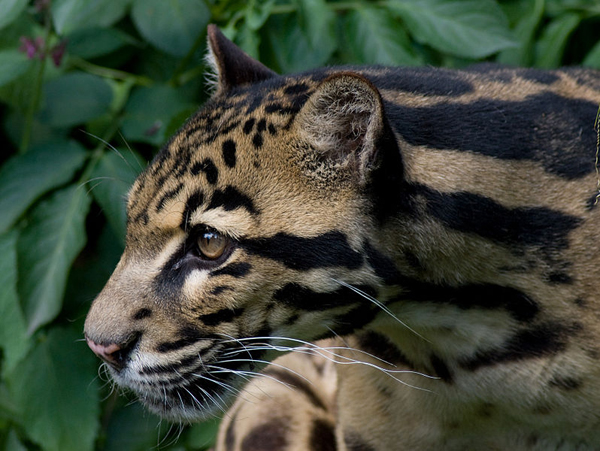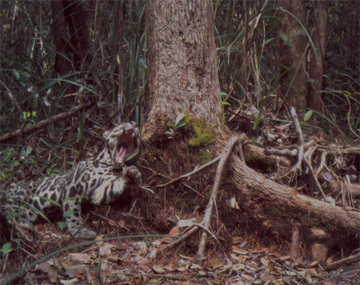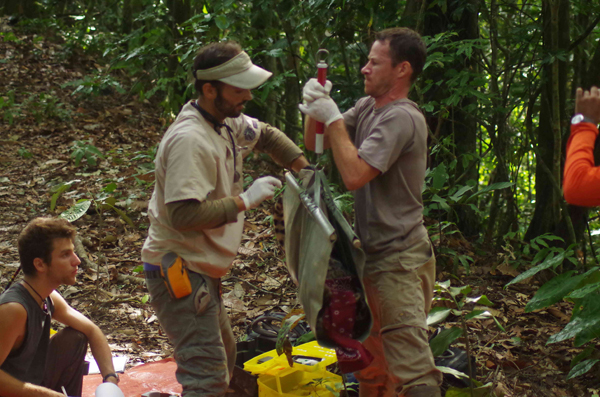December 22, 2013
Recently, two ambitious studies set out to change that. The aim of both was to better protect the leopard by learning more about its movements throughout its habitat. Both studies were quickly released on the organizations' websites as major press releases. One study, lead by the Orangutan Tropical Peatland Project (OuTrop) conducted an intensive study on populations inhabiting bogs. Another, with the Sabah Wildlife Department, WildCRU and Danau Girang Field Centre, fitted a wild Sunda clouded leopard with a satellite collar to track its movements, marking the first time the species had ever been collared.
 A
close up of a Sunda clouded leopard. Photo courtesy of Spencer Wright
under a Creative Commons Attribution 2.0 Generic license.
A
close up of a Sunda clouded leopard. Photo courtesy of Spencer Wright
under a Creative Commons Attribution 2.0 Generic license.
The collaring project team captured a male Sunda leopard in Borneo's Kinabatangan forest. Until then, researchers had to rely on camera traps or sheer luck to catch a glimpse of the cat. After the team weighed and photographed the leopard, it was fitted with a sophisticated satellite collar that will report its movements every 20 minutes for the next four to six months.
 A camera trap photo of the elusive clouded leopard. Photo courtesy of The Orangutan Tropical Peatland Trust. |
The OuTrop project had similar motivations in mind. In a study from 2008-2012, researchers from OuTrop, WildCRU at Oxford University, the Cardiff School of Biosciences and the Center for International Cooperation in Sustainable Management of Tropical Peatland used 54 camera traps in 27 different locations. During the four years of the study, the researchers captured 90 images of six different Sunda clouded leopards. Although that number may seem small, it surprised the researchers.
"The densities are higher than we were expecting," lead researcher Susan Cheyne told mongabay.com. "Extrapolating from these density estimates, there could be as many as 247 clouded leopards in the 5,600 square kilometer Sabangau Forest."
The OuTrop study was based in the Borneo peat-swamp forests, which are flooded for up to nine months the year.

Veterinarian Fernando Nájera preparing to collar and collect samples from an anesthetized Sunda clouded leopard as part of a conservation research project. Photo by Danau Girang Field Centre.

A male Sunda clouded leopard captured on one of the camera traps. Photo by Danau Girang Field Centre.
"No information was known about clouded leopards in this habitat so we wanted to investigate the behavioral ecology and population of this forest," said Cheyne.
"Due to the large area of peatland forest in Indonesian Borneo, this habitat could support large populations of clouded leopards," said Cheyne. "But peatland is also targeted by plantation and logging companies so the conservation threats combined with the potential importance of these forests for clouded leopards mean this is crucial habitat."
Becoming a crucial habitat for the Sunda leopard, an endangered species, means more protection for the peatland habitat, something vital for the survival of the species.
Knowledge is power, and both studies have exciting conservation implications for the future.

Anesthetized Sunda clouded leopard. Minutes later the animal was revived using a reversal drug and released back into the forest. Photo by Danau Girang Field Centre.
"By better understanding the clouded leopard ecology and habitat, we will be able to unlock some of Sabah's (a state in Malaysian Borneo) closely guarded secrets about their behavior and how habitat loss and fragmentation have impacted Sabah's biggest wild cat," said Sen Nathan, from the satellite collaring program. "We also hope that with more accurate data collected on its home range via satellite collars, we will be able to provide a better management of this beautiful cat in such a modified landscape."
More than half of the world's tropical timber products come from Borneo, and enormous swaths of forest are being burned to make room for palm oil plantations. Because they are sparsely populated and regarded as unproductive, peat swamp forests are often the first choice for deforestation. The results of these studies both offer hope and heighten alarm as industrial activities in Borneo increase.

As part of a conservation research study a male Sunda clouded leopard is weighed whilst chemically anesthetized. Photo by Danau Girang Field Centre.
Citations:
- Andreas Wilting, Per Christiansen, Andrew C. Kitchener, Yvonne J.M. Kemp, Laurentius Ambu, Jörns Fickel. Geographical variation in and evolutionary history of the Sunda clouded leopard (Neofelis diardi) (Mammalia: Carnivora: Felidae) with the description of a new subspecies from Borneo. Molecular Phylogenetics and Evolution, 2010; DOI: 10.1016/j.ympev.2010.11.007
Please visit Mongo Bay (source of article) and consider a donation
No comments:
Post a Comment